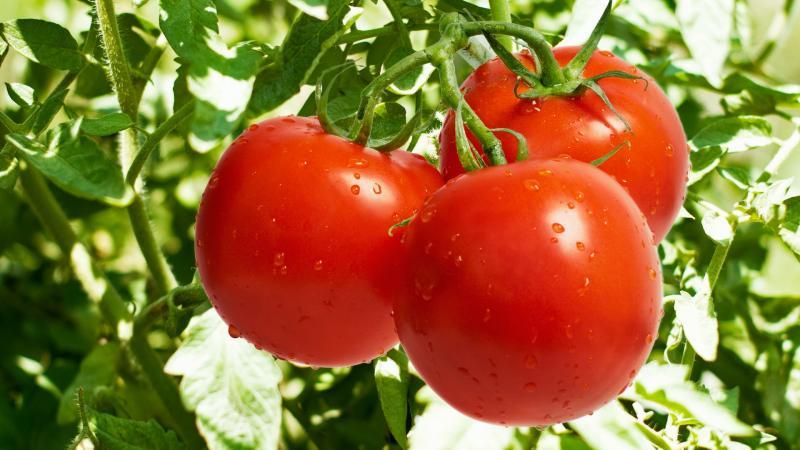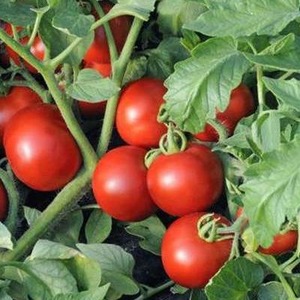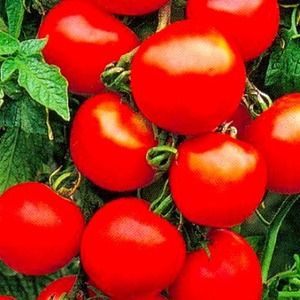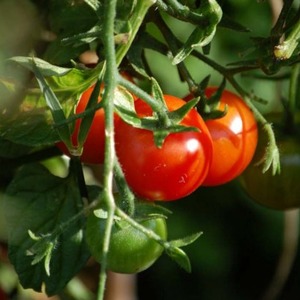A favorite of vegetable growers, a variety donated by Russian breeders - tomato "Olya F1"
Russian breeding never ceases to amaze with a variety of crops, and the relatively new tomato variety Olya f1 is another proof of progress. High yield, disease resistance, good adaptation to weather whims, excellent taste of the fruit did not hide from the vigilant summer residents, and now the hybrid adorns the beds in many regions of our country. In addition, maintenance is so minimal that even a beginner can get a rich harvest of delicious tomatoes.
The content of the article
Description of the variety
Olya f1 variety was developed by Russian scientists at the beginning of the XXI century. He quickly gained popularity among vegetable growers. This variety is super determinate, non-standard. Plants reach a height of 100-120 cm.
Distinctive features
Tomato variety Olya f1 is grown in winter-spring and spring-summer periods, as well as in extended circulation, that is, without transplanting into a greenhouse until November or December.
In the interval between the leaves, in internodes, three brushes are laid at once. The first of them are formed over 7-9 leaves, each with seven fruits.
Reference. Fruit ovary occurs at night at 7 ° C or during the day at 13 ° C. No tomato has this ability, many of the species stop pollination at this temperature and shed flowers.
From the moment of emergence of shoots to full maturation, 90-100 days pass, in the extended circulation - 105 days.
The Olya f1 variety has an increased resistance to diseases of the tomato series, such as cladosporium, fusarium and tobacco mosaic. It is distinguished by shade tolerance and heat resistance. The tomato is recommended for cultivation in greenhouse conditions and open field. In a greenhouse, a hybrid can be grown all year round.

Fruit characteristics and yield
The harvest is rich: from 1 sq. m, you can collect up to 15 kg of fruits, in extended circulation - up to 25 kg.
Due to the small number of shoots, pinching is not required, but you cannot do without a garter.
The fruits are medium, their weight can reach 170 g. They have a rounded shape and bright red color (see photo above), sweet and sour taste. These tomatoes contain 4-6 seed chambers.
The purpose of the tomato is universal: it is suitable for fresh consumption, pickling, pickles, preservation, making sauces, ketchup and other dishes.
How to grow seedlings
Summer residents are preparing for the season already in February-March. Quality seeds and seedlings are the key to getting a good harvest.
Seed preparation
 To prevent disease, seeds are disinfected with potassium permanganate or hydrogen peroxide. A proven method is to soak the seeds for 20 minutes in a 1% solution of potassium permanganate.
To prevent disease, seeds are disinfected with potassium permanganate or hydrogen peroxide. A proven method is to soak the seeds for 20 minutes in a 1% solution of potassium permanganate.
Then they need to be saturated with nutrients. To do this, use solutions of potassium or sodium humate, aloe vera juice or potato water. There are also special drugs, for example, "Immunocytofit".
It remains to harden the seeds. Tomatoes love warmth, and this procedure will help them cope with unexpected changes in temperature. Seeds, which gave the first shoots, are left in the refrigerator overnight, and then returned to the heat for a day. This should be done 2-3 times.
Sowing
It begins 45-55 days before planting seedlings in the ground. Seeds are sown in small containers, common or individual. The soil is prepared from one part of peat, one part of sawdust and two parts of greenhouse soil.The sawdust is pre-disinfected with boiling water, then steamed with a hot urea solution.
To one bucket of prepared soil add two handfuls of crushed shells, 0.5 liters of ash, 2 tbsp. l. superphosphate. Then mix thoroughly and pour in a hot light-colored manganese solution. When the ground cools down, fill the planting containers by half.
After planting the seeds, the containers are covered with foil or glass and left indoors at a temperature of 22-24 ° C.
When shoots appear, the film is removed and the containers are rearranged to a more illuminated place. Since the tomato is shade-tolerant, it is not necessary to expose the seedlings in a sunny place.
The first watering for 2 tsp. spend on the fourth day, distributing water along the edge of the nursery. After the formation of the third leaf, 100 ml of water is allocated for each bush.
When two real leaves appear seedlings dive, seating in separate containers. To slow down the outgrowth of seedlings, it is dived again after 21 days.
Reference.The pick promotes the development of lateral roots, which leads to the strengthening of the seedlings.
At the age of seven days, the sprouts are sprayed with Epin to enhance immunity. The first feeding is carried out 10 days after the first picking with Fertika Lux or Pure Leaf fertilizer.
Two weeks before transplanting, the seedlings begin to harden. To do this, they are taken outside for 2-3 hours, and the night temperature in the room where the seedlings are located is reduced to 14 ° C. Gradually, the time spent outside the sprouts increases to 18 hours.
How to grow tomatoes
After 45-55 days, the seedlings are ready for transplanting into open ground.
Planting pattern: 50 cm - distance between bushes, 40 cm - between rows. For 1 sq. m, no more than six seedlings are placed, otherwise fruiting will decrease.
After planting in shallow holes, the soil is loosened, spud and moderately watered with warm, settled water. Watering produced at the root of the plant. Further watering is carried out as the soil dries, but not more often 1-2 times a week. For a longer retention of moisture, the soil is mulched.
Reference.Loosening the soil facilitates better oxygen supply to the roots.
 During the growing season, the plant is fed with mineral complexes in the form of phosphorus and potassium fertilizers every 14 days.
During the growing season, the plant is fed with mineral complexes in the form of phosphorus and potassium fertilizers every 14 days.
Feed nitrogen fertilizers are undesirable due to the formation of a large amount of greenery, while there will not be enough nutrients for fruit setting.
Due to the small number of shoots, the culture in pinching does not need. But if the stepson appears before the first fruitful brush, he is removed. This is the lowest process that is not involved in the development of the seedling and can cause late blight.
Saplings must be tied to wooden or metal rods. As it grows, the stem is gently fixed to the support. It is also possible to commit branches.
Features of cultivation and possible difficulties
Tomato Olya f1 grows tall, and several brushes appear on the central shoot at once. Therefore, experienced gardeners grow this variety in two shoots, when the second is launched from under the first brush. Remove all flowers and the top - this will help Ole not waste nutrients on unnecessary tops.Sprinkle the cut area immediately with charcoal or activated carbon.
It is important to remove lateral shoots in time: when the stepsons have reached a height of 3-4 cm. Pluck them at the very base in the morning and in dry weather. If you leave the tip, it will start to rot and poison the entire bush.
Don't overfeed tomatoes! If you give them too much manure, the bush will grow and the fruit will be small and green.
Diseases and pests
 The hybrid is considered a highly resistant crop to the main diseases of the Solanaceae family. Nevertheless, sometimes it is powerless against late blight and brown spot.
The hybrid is considered a highly resistant crop to the main diseases of the Solanaceae family. Nevertheless, sometimes it is powerless against late blight and brown spot.
Late blight is prevented by loosening the soil, removing weeds and moderate watering.The main thing is to monitor the level of humidity.
Late blight is a fungal disease that is very fond of the abundance of moisture and high ambient temperatures. Copper sulfate is also suitable as a prophylactic agent.
In the treatment of phytophthora, the fungicide "Hom" will help, treatment with furacilin or soda (1 tbsp. L for 0.5 buckets of water).
Brown spot is also a fungal disease, so preventive measures will be similar. As for the treatment, copper-containing fungicides, for example, "Barrier" (8 g per 10 liters of water) will help here.
Of the pests, the bear and the Colorado potato beetle are dangerous. Medvedka is scared away by pungent odors, for example, a crushed head of garlic, which is buried in the ground. And the Colorado potato beetle, along with its larvae, are harvested by hand and burned in glass jars.
The nuances of growing in an open field and a greenhouse
The variety is recommended for cultivation in open ground and greenhouse conditions. For open ground, the climate of the North Caucasus region is suitable. In greenhouses, tomatoes are grown all year round, regardless of climatic conditions.
In the greenhouse, the height of the seedlings reaches 1.2 m. This is slightly higher than in open beds. At this height, up to 15 brushes are formed on the trunk. The fruits ripen simultaneously on three branches, differing little in size from each other.
In both protected and unprotected soil, all the lower leaves are removed, otherwise, with constant contact with moisture, the leaves can rot.
It is necessary to exclude the thickening of plantings both in the greenhouse and in the beds. Otherwise, many parasitic insects may be overlooked. In addition, the frequency of planting leads to a decrease in yield.
If the tomato is planted in a greenhouse, it must be regularly ventilated.
Harvesting and application of the crop
The collection of greenhouse vegetables begins in mid-May, and the beds in the open field delight with ripe tomatoes from the beginning of June. Fruit ripening is amicable, three brushes ripen at once, vegetables of almost the same size. Harvesting is best done before noon, before the sun has time to heat the fruit. Vegetables can be harvested immature - they are able to pick up color on their own.
The characteristics of the Olya f1 tomato make it a versatile treat. It is equally suitable for fresh consumption and preservation. Small tomatoes are good for canning whole fruits. They do not lose their taste in marinades and pickles, they are used to make adjika, ketchup, lecho, juices, pasta and sauces. Tomatoes are suitable for baking with meat and preparing first courses, they are also frozen and dried.
Tomatoes retain their presentation for a long time.
Advantages and disadvantages
The hybrid has many positive qualities, thanks to which the number of its fans is growing:
 high rate of fruiting;
high rate of fruiting;- cold resistance;
- heat resistance;
- shade tolerance;
- high adaptation to any weather conditions;
- the ability to grow in low light;
- increased resistance to disease;
- optional pinching;
- great fruit taste;
- unpretentious care;
- presentation of vegetables;
- versatility in cooking.
The disadvantages of any hybrid include the inability to independently select seeds for the next sowing. Here you can add the need for a garter.
Farmers reviews
Tomato Olya f1 is characterized by gardeners as an unpretentious crop to care for. To obtain a tasty harvest, the plant only needs regular watering and systematic feeding. Here are some reviews of summer residents:
 Elena, Chelyabinsk: “I really like this hybrid. Despite the extreme summer in our area, the vegetable crop is always good. The fruits grow even, dense, moderately juicy. "
Elena, Chelyabinsk: “I really like this hybrid. Despite the extreme summer in our area, the vegetable crop is always good. The fruits grow even, dense, moderately juicy. "
Olga, Syzran:“I plant a variety of tomato Olya from year to year and I'm not going to refuse. Let the tomatoes be small, but the care is minimal, the tomato bears fruit abundantly and is sufficiently resistant to weather changes. I make whatever I want out of it.In winter, I am happy to look at the photographs of my summer harvest. "
Tatiana, Zvenigorod:“I recommend this hybrid to everyone. For watering and feeding, he will reward with selected vegetables. You don't need to step-son, which is very convenient. Minimum strength - maximum result. This has already become my dacha motto. "
Conclusion
To everyone who still doubts which variety of tomatoes to choose for the garden, vegetable growers advise the tomato Olya f1. Easy to care for, high-yielding, disease-resistant, cold-tolerant, does not require a lot of light, versatile in cooking, it will perfectly take root in any summer cottage. In addition, the possibility of growing it all year round in a greenhouse means that you will have fresh vegetables on your table, even during the cold season.